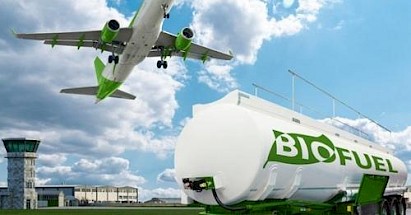First Passenger Flight Using 100% Sustainable Aviation Fuel is Officially Off the Ground!
 United Airlines flew the world’s first passenger flight powered by 100% sustainable aviation fuels (SAFs) Wednesday, from Chicago’s O’Hare International Airport to Reagan Washington National.
United Airlines flew the world’s first passenger flight powered by 100% sustainable aviation fuels (SAFs) Wednesday, from Chicago’s O’Hare International Airport to Reagan Washington National.
Driving the news: The 737 MAX 8 flew with a high-ranking delegation aboard, including members of Congress, United CEO Scott Kirby, and partners in the newly expanded Eco-Skies Alliance, which includes companies such as Siemens, Palantir and Salesforce.
The big picture: Aviation is one of several difficult-to-decarbonize sectors of the economy, particularly as airlines and plane manufacturers already work to wring every possible efficiency savings out of an airframe, such as building planes with lightweight materials and using more fuel-efficient engines.
Details: Sustainable fuels, which can currently be made from feedstocks like household waste or algae, can already be blended with traditional aviation fuel, known as Avgas. But current regulations limit that SAF mixture to a blend of up to 50% to power routine passenger flights. Burning 100% SAFs as an experimental move marks a new step.
- The flight used 500 gallons of SAF in one engine, and the same amount of conventional jet fuel in the other to prove a lack of operational differences between the two that could affect aircraft performance.
- United boasts that it currently has agreements to purchase about twice as much SAF as “the known agreements of all other global airlines combined,” according to a statement.
- Kirby said it will require $250 billion to scale up SAF production to the point where flights like the one yesterday are routine rather than a rarity to be greeted with a hangar celebration.
Yes, but: While SAFs would help decarbonize air travel, they won’t eliminate its carbon footprint, because the amount of emissions depends on the feedstocks used to make the fuel.
What they’re saying: Rep. Sean Casten (D-Ill.), who has advocated for legislation to incentivize SAF research, development and production, told Axios the limiting factor right now is a lack of available sources for making sustainable fuels.
- Overcoming this obstacle, however, is vital, Casten said.
- “I don’t know how you decarbonize [aviation] without SAFs,” he said.
- For example, American Airlines’ plan for reaching net-zero emissions in 2050 relies heavily on SAFs to get there.
You can return to the main Market News page, or press the Back button on your browser.

